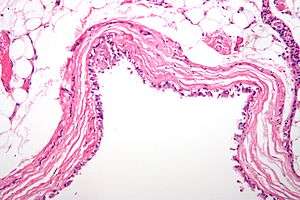Cyst
| Cyst | |
|---|---|
|
| |
| Classification and external resources | |
| Specialty | Pathology, general surgery |
| MedlinePlus | 003240 |
| MeSH | D003560 |
A cyst is a closed sac, having a distinct membrane and division compared to the nearby tissue. Hence, it is a cluster of cells that have grouped together to form a sac (not unlike the manner in which water molecules group together, forming a bubble); however, the distinguishing aspect of a cyst is that the cells forming the "shell" of such a sac are distinctly abnormal (in both appearance and behaviour) when compared to all surrounding cells for that given location. It may contain air, fluids, or semi-solid material. A collection of pus is called an abscess, not a cyst. Once formed, a cyst may sometimes resolve on its own. When a cyst fails to resolve it may need to be removed by surgery but this will depend on what type of cyst it is and where in the body it has formed.
Some cysts are neoplastic and are thus called cystic tumors; many types are not neoplastic. Some are dysplastic or metaplastic. Pseudocysts are similar to cysts (having a sac filled with fluid) but lack an epithelial lining.
Types
- Acne cyst – Pseudocysts associated with cystic acne. Actually an inflammatory nodule with or without an associated epidermoid inclusion cyst.
- Arachnoid cyst (between the surface of the brain and the cranial base or on the arachnoid membrane)
- Baker's cyst or popliteal cyst (behind the knee joint)
- Bartholin's cyst (near the vagina)
- Breast cyst
- Buccal bifurcation cyst[1]
- Calcifying odontogenic cyst
- Ceruminous cyst (ear)
- Chalazion cyst (eyelid)
- Chocolate cyst of ovary
- Choroid plexus cyst (in the brain)
- Colloid cyst (in the brain)
- Cysticercal cyst - an infection due to the larval stage of Taenia sp. (Crain's backs)
- Dentigerous cyst (associated with the crowns of non-erupted teeth)
- Dermoid cyst (ovaries, testes, many other locations from head to tailbone)
- Epididymal cyst (found in the vessels attached to the testes)
- Fibrous cyst (breast)
- Ganglion cyst (hand/foot joints and tendons)
- Glandular odontogenic cyst
- Glial cyst (in the brain)
- Gartner's duct cyst (vaginal or vulvar cyst of embryological origin)
- Hydatid cyst (an infection in the liver or other parts of the body due to the larval stage of Echinococcus granulosus (tapeworm))
- Hydrocele (testicle)
- Keratocyst (in the jaws, these can appear solitary or associated with the Gorlin-Goltz or Nevoid basal cell carcinoma syndrome. The latest World Health Organization classification considers Keratocysts as tumors rather than cysts)
- Liver cystic disease
- Meibomian cyst (eyelid)
- Mucoid cyst (ganglion cysts of the digits)
- Mucous cyst of the oral mucosa
- Myxoid cyst (cutaneous condition often characterized by nail plate depression and grooves)
- Nabothian cyst (cervix)
- Nasolabial duct cyst
- Odontogenic cyst (teeth)
- Ovarian cyst (ovaries, functional and pathological)
- Pancreatic cyst
- Paradental cyst
- Parapelvic cyst (kidney)[2]
- Paratubal cyst (fallopian tube)
- Periapical cyst - This cyst, also known as radicular cyst, is the most common odontogenic cyst
- Pericardial cyst[3]
- Peritoneal cyst (lining of the abdominal cavity)
- Pilar cyst (cyst of the scalp)
- Pilonidal cyst (skin infection near tailbone)
- Renal cyst (kidneys)
- Polycystic ovary syndrome
- Pineal gland cyst (in the pineal gland in the brain)
- Radicular cyst - associated with the roots of non-vital teeth, also known as periapical cyst
- Residual cyst
- Sebaceous cyst - sac below skin
- Skene's duct cyst, a paraurethral cyst
- Spermatocele (testicle)
- Stafne static bone cyst (An anatomic variant with radiographic cystic appearance in the posterior mandible)
- Tarlov cyst (spine)
- Thyroglossal cyst
- Trichilemmal cyst – Same as a pilar cyst. A familial cyst of the scalp.
- Vocal fold cyst
The aneurysmal bone cyst is a neoplastic cyst, more specifically an aggressive lesion with radiographic cystic appearance.[4]
Cystic fibrosis
Despite being described in 1938 as the microscopic appearance of cysts in the pancreas,[5] cystic fibrosis is an example of a genetic disorder whose name is related to fibrosis of the cystic duct (which serves the gallbladder) and does not involve actual cysts.[6]
This is just one example of how the Greek root cyst-, which simply means a fluid-filled sac, is also found in medical terms that relate to the urinary bladder and the gallbladder but that have nothing to do with cysts.
Cystic neoplasm
Examples of neoplastic cysts include:
Treatment
Treatment ranges from simple enucleation of the cyst to curettage to resection. There are cysts—e.g., buccal bifurcation cyst—that resolve on their own, in which just close observation can be employed, unless it is infected and symptomatic.[1]
Related structures
A pseudocyst is collection without a distinct membrane.
A syrinx in the spinal cord or brainstem is sometimes inaccurately referred to as a cyst.
See also
References
- 1 2 Zadik Y, Yitschaky O, Neuman T, Nitzan DW (May 2011). "On the Self-Resolution Nature of the Buccal Bifurcation Cyst". J Oral Maxillofac Surg. 69 (7): e282. doi:10.1016/j.joms.2011.02.124. PMID 21571416.
- ↑ Parapelvic cyst
- ↑ Pericardial cyst
- ↑ Zadik, Yehuda; Aktaş Alper; Drucker Scott; Nitzan W Dorrit (2012). "Aneurysmal bone cyst of mandibular condyle: A case report and review of the literature". J Craniomaxillofac Surg. 40 (8): e243–8. doi:10.1016/j.jcms.2011.10.026. PMID 22118925.
- ↑ Andersen, D.H. (1938). "Cyst leiesic fibrosis of the pancreas and its relation to celiac disease". Am J Dis Child. 56: 344–399. doi:10.1001/archpedi.1938.01980140114013.
- ↑ Greenholz SK, Krishnadasan B, Marr C, Cannon R (1997). "Biliary obstruction in infants with cystic fibrosis requiring Kasai portoenterostomy". J. Pediatr. Surg. 32 (2): 175–9; discussion 179–80. doi:10.1016/S0022-3468(97)90174-3. PMID 9044117.
External links
- "Cyst Symptoms and Causes" by Melissa Conrad Stöppler, MD and William C. Shiel, Jr., MD, FACP, FACR.
